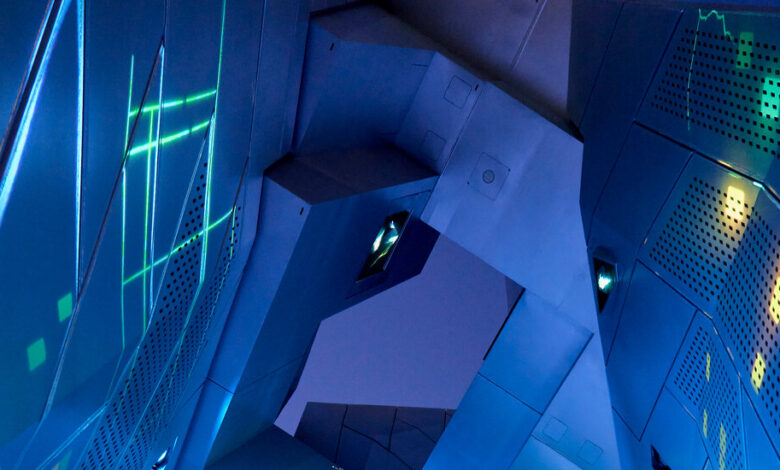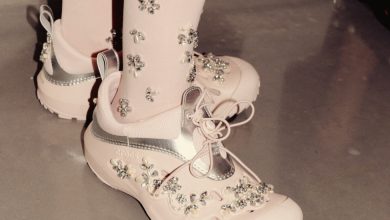There’s a New Billboard in Town, and You Can Walk in

Those billboards that blight much of the American landscape are, along the Sunset Strip in Hollywood, the landscape itself — a dense, linear forest of sizzling images advertising the hottest stars and the latest albums and movies. By the time motorists in rush hour have run the two-mile gantlet of these glamour tapestries, some of them digital, they have learned just who’s who and what’s what in America’s now culture.
For decades, billboards along this stretch of Sunset have been status symbols coveted by artists and studios, but since the advent of the smartphone, the wide-screen cinematic format echoing Hollywood’s theatrical movie screen has instead transformed itself into a vertical format echoing the little screen in everyone’s palm.
That transformation, however, is now facing another shift, in the form of a tall, complex, high-tech structure brought to the Strip by the Los Angeles architect Tom Wiscombe. Instead of a steel column stiffly supporting a billboard the avant-garde designer created a tepee of irregularly shaped, leaning vertical planes programmed with digital art and ads, all specifically designed for irregular screens.
Wiscombe, a professor at Southern California Institute of Architecture (known as SCI-Arc) in downtown Los Angeles, brought the flat screen of the usual billboard into the third dimension, obeying architecture’s first commandment: Let there be space.
The 52-year-old designer updates the commandment by streaming digital art and ads onto his angular structure, integrating what he calls our “mediated life” into a 3-D environment. “Smartphones can start to create architectural and civic rooms in the city,” he says.
In 2016, the city of West Hollywood, known for its innovative urban design and planning, held the “Sunset Spectacular Billboard Competition,” inviting advertising companies to pair with architects to reinvent what a billboard might be, especially on this boulevard where billboards constitute the sequoias of the entertainment industry’s national park.
The competition brief assumed that offerings would not just switch out the old analog format for its digital replacement. Designers should speculate: What can be incorporated beyond advertising? How can art be integrated? How does it serve West Hollywood-related events like the Pride Parade, and a broader civic purpose?
Competing advertising companies hired their own architects and designers, and Wiscombe’s proposal, “West Hollywood Belltower,” sponsored by Orange Barrel Media, based in Columbus, Ohio, prevailed over those by Zaha Hadid Architects, Gensler, and Tait Towers, groups practicing internationally.
Two months ago, after years of town meetings, approvals and high-tech fabrication, construction fences finally came down around Wiscombe’s towering $14 million structure, sited in a bend of Sunset at Holloway Drive at the edge of a new parking lot furnished with electric power stations and a small public square designed for markets and events.
“The first thing that I wanted to do was make a billboard that included an interior space,” says Wiscombe, who also designed the parking lot. “I decided to multiply the normal billboard and basically lean three vertical surfaces against each other. A superstructure inside connects them, like the vaults of a Gothic cathedral. You now walk in, look up, and see all of this interconnected structure.”
Like a performance stage, Wiscombe’s inviting chapel is packed with digital and mechanical infrastructure, including data conduits, a water cooling system, computer-controlled electrical lighting, video projectors, and an interactive audio system that animate the space with moving, colored projections that are especially vivid after dark.
The American billboard was invented long ago for visibility from the car, and in its Hollywood version, it sometimes served as an elevated stage for casts acting scenes from a movie. “The technology has changed, but the Sunset billboard still celebrates pop culture in the highest profile location for the entertainment industry,” says Pete Scantland, founder and chief executive of Orange Barrel Media.
Wiscombe’s design, which fuses architecture, art, media and an interactive pedestrian experience, transforms the usual “sign on a stick.” People leaving their cars can now walk through a theater capsule of kinetic images illuminating steel plates overhead on their way to Sunset Boulevard. Tourists spill out of buses for a stroll in and around the towering new destination point in the city, immersing themselves in streaming digital images projected onto LED screens outside and on the right-angled architectural storm inside.
“Art, architecture and civic space are all intertwined,” Wiscombe said.
The angular tower stages and frames the show. The overhead scaffold inside is not the usual steel frame with conventional I-beams but a complex web of custom-perforated, laser-cut steel plates welded together in a giant three-dimensional jigsaw that pierces the exterior planes at an oblique angle, leaving distorted, coffered fingerprints around the LED billboards facing the street.
The irregular shape of the screen obligates advertisers to create unique ads rather than one-size fits-all images for the increasingly standardized billboard. “The format and the prominence of the location prompts advertisers to step up their game to produce something unique,” says Scantland, who is now sponsoring other innovative architect-designed billboards on the Strip in West Hollywood.
Amazon Music, Chanel and Meta have all recently produced ads whose graphic punch delivers a sales pitch digestible at 35 m.p.h. For 10 minutes at the top of each hour, however, digital art by prominent local and international artists plays on the two screens, surprising displays here because they aren’t selling a product. Selected by the independent, Los Angeles-based art curator Diana Nawi, videos have included vintage shots of herds of surfers bobbing on their boards (by Catherine Opie) and grotesquely contorted faces pressed against glass as though against LED screens (by Pipilotti Rist). Artists can take over and “play” billboards and the chapel like a carillonneur playing a carillon. In addition to radical transformation of billboard design, art for the sake of art really distinguishes Sunset Spectacular from all the billboards on the Strip.
Wiscombe’s meccano tower, with its resemblance to a transformer, could be a robot acting in a sci-fi film. “Architecture has always been a cottage industry in which we ship a bunch of sticks and panels and pieces of stone to a construction site,” says Wiscombe, whose portfolio of projects has been inspired by aerospace and naval engineering. “This design is somewhere between a prototype for a building and a prototype for something in the aerospace industry. It’s built more like an advanced jet fighter than architecture. If the billboard helps pave the way for future billboards, it’s also a pilot project for building in the 21st century.”
As a billboard, Wiscombe’s building has traded in a picture still taken from a movie for the experience of immersively occupying a film. Pedestrians are now actors walking through a scene that transforms images into walk-in, walk-through realities. You are out there.




